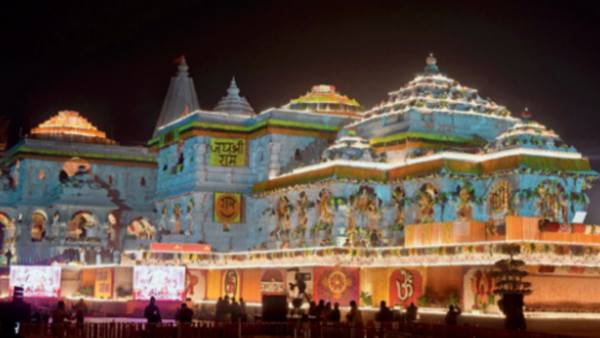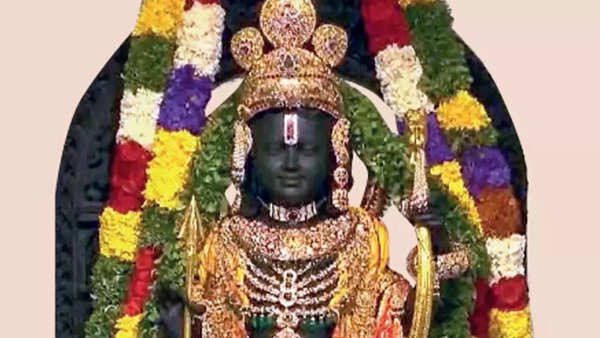Trending
Ram Temple Consecration (Pran Pratishtha) Ceremony
Nearly four years after the Supreme Court paved the way for the construction of Ram Mandir at Ram Janmabhoomi in Ayodhya, crores of devotees around the world will finally get a glimpse of the newly-built Nagara-style temple on January 22 during the grand consecration ceremony in the holy town. An idol of Ram Lalla (5-year-old deity) will be installed in the sanctum sanctorum of the temple in the presence of Prime Minister Narendra Modi and other dignitaries during a sacred ceremony, guided by saints and seers. The public will be able to seek darshan of the deity after the morning of January 27.
CM Adityanath urges devotees at Ram temple to be patient and cooperate with authorities. He assures that Ram Lalla will give 'darshan' to all and the government is working tirelessly for smooth 'darshan'. Approximately three lakh devotees have already visited the temple.
The newly built Maharishi Valmiki International Ayodhya Airport handled 123 flights, including 101 chartered flights, for the pran pratishtha ceremony at the Ram Temple. The airport welcomed 4,500 guests, including 350 VIPs. The Central Industrial Security Force (CISF) provided hassle-free and secure passenger movement.
Trending Topics
Photos






More Stories
The years-long wait for a "bhavya" (grand) Ram Mandir in Ayodhya ends in the first month of 2024 as the Shri Ram Janmabhoomi Teerth Kshetra unveils the sprawling temple to the world during a mega consecration (pran pratishtha) ceremony on January 22. Built to last at least a 1,000 years, the temple was constructed at an estimated cost of Rs 1,800 crore and is made of pink sandstone and carved marble. A symbol of religious significance, the temple showcases a blend of intricate architecture, cultural design elements and modern amenities while also prioritising environmental sustainability. Here's more about temple:
Architecture
● Traditional Nagara style temple with a length of 380 feet, a width of 250 feet, and a height of 161 feet.
● Nagara architecture originates in North India and features tall pyramidal towers (Shikharas) with Kalash at the top.
● Pillars are intricately carved, and walls are adorned with sculptures and reliefs.
Structure Details
● Three-storied temple with each floor being 20 feet tall, housing 392 pillars and 44 doors.
● The Garbha Griha is the inner sanctum where the idol of Lord Ram (Shri Ram Lalla) resides.
● First floor hosts a Shri Ram Darbar, while the temple comprises five halls (Mandaps) for various purposes.
Design and Decor
● Statues of deities, gods, and goddesses embellish the pillars and walls.
● Intricate designs adorn the pillars, and the temple features multiple Mandaps for different functions.
Accessibility and Surroundings
● Entry is through the Singh Dwar from the east, facilitated by 32 stairs with ramps and lifts for the differently-abled and elderly.
● The compound wall (Parkota) spans 732 meters with a width of 14 feet and encloses the Mandir.
● Four Mandirs are at each corner dedicated to Surya Dev, Devi Bhagwati, Ganesh Bhagwan, and Bhagwan Shiv.
Adjacent Features
● Nearby structures include a historic well (Sita koop), dedicated Mandirs to various sages, and the restored ancient Mandir of Bhagwan Shiv at Kuber Tila.
Construction and Facilities
● The Mandir avoids using iron and incorporates a 21-foot-high plinth using granite to prevent ground moisture.
● The foundation includes a 14-meter-thick layer of roller-compacted concrete (RCC) resembling artificial rock.
● Facilities within the complex include sewage and water treatment plants, fire safety water supply, and an independent power station.
● A Pilgrims Facility Centre (PFC) for 25,000 people provides medical and locker facilities. Separate bathing areas and washrooms are planned.
Environmental Focus
● The Mandir's construction primarily employs Bharat's traditional and indigenous technology.
● Emphasis on environmental conservation, with 70% of the 70-acre area dedicated to greenery and water conservation measures.
Architecture
● Traditional Nagara style temple with a length of 380 feet, a width of 250 feet, and a height of 161 feet.
● Nagara architecture originates in North India and features tall pyramidal towers (Shikharas) with Kalash at the top.
● Pillars are intricately carved, and walls are adorned with sculptures and reliefs.
Structure Details
● Three-storied temple with each floor being 20 feet tall, housing 392 pillars and 44 doors.
● The Garbha Griha is the inner sanctum where the idol of Lord Ram (Shri Ram Lalla) resides.
● First floor hosts a Shri Ram Darbar, while the temple comprises five halls (Mandaps) for various purposes.
Design and Decor
● Statues of deities, gods, and goddesses embellish the pillars and walls.
● Intricate designs adorn the pillars, and the temple features multiple Mandaps for different functions.
Accessibility and Surroundings
● Entry is through the Singh Dwar from the east, facilitated by 32 stairs with ramps and lifts for the differently-abled and elderly.
● The compound wall (Parkota) spans 732 meters with a width of 14 feet and encloses the Mandir.
● Four Mandirs are at each corner dedicated to Surya Dev, Devi Bhagwati, Ganesh Bhagwan, and Bhagwan Shiv.
Adjacent Features
● Nearby structures include a historic well (Sita koop), dedicated Mandirs to various sages, and the restored ancient Mandir of Bhagwan Shiv at Kuber Tila.
Construction and Facilities
● The Mandir avoids using iron and incorporates a 21-foot-high plinth using granite to prevent ground moisture.
● The foundation includes a 14-meter-thick layer of roller-compacted concrete (RCC) resembling artificial rock.
● Facilities within the complex include sewage and water treatment plants, fire safety water supply, and an independent power station.
● A Pilgrims Facility Centre (PFC) for 25,000 people provides medical and locker facilities. Separate bathing areas and washrooms are planned.
Environmental Focus
● The Mandir's construction primarily employs Bharat's traditional and indigenous technology.
● Emphasis on environmental conservation, with 70% of the 70-acre area dedicated to greenery and water conservation measures.
















